1451 - Domenico Colombo and Susanna Fontanarossa gave birth to Christopher Columbus in Genoa, Italy. He would be the oldest of three brothers named Bartolomeo, Giovanni Pellegrino, and Giacomo, and one sister named Bianchinetta.
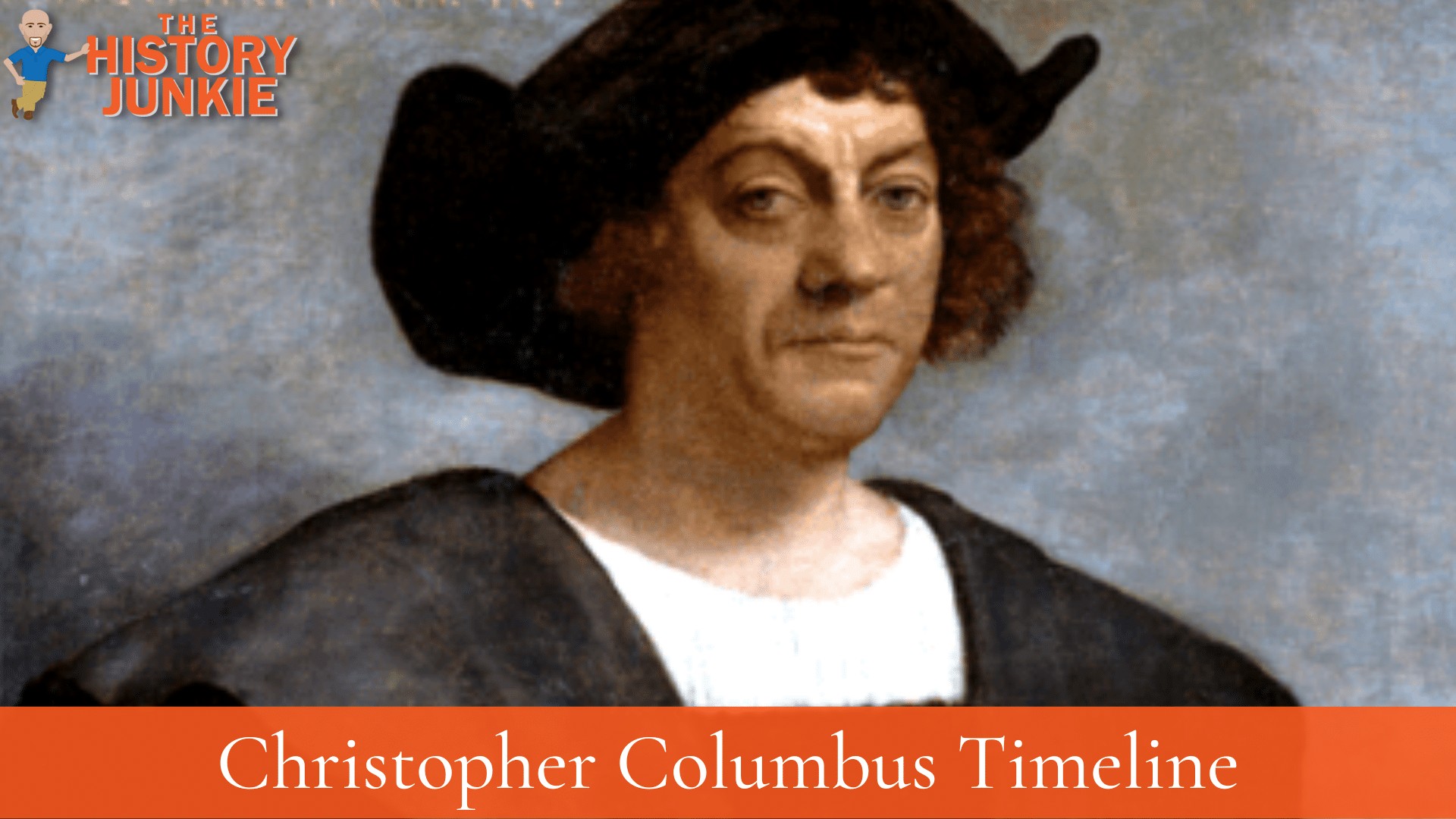
1470 - At the age of 19, Christopher Columbus would begin his maritime career as a privateer/pirate in the Mediterranean Sea. It would be during this time that he would show a talent for navigation. Around this time, his family moved from Genoa to Savona, which is roughly 35 miles west.
1473 - Christopher Columbus began his apprenticeship as a business agent for the wealthy Spinola, Centurione, and Di Negro families of Genoa.
1476 - He had a near-death experience when his boat sank off the coast of Portugal due to a pirate attack. He floated ashore on a scrap of wood in Lisbon. While in Portugal, he began to study mathematics, astronomy, cartography, and navigation.
1479 - He meets and marries Felipa Perestrello Moniz. She was the daughter of Bartolomeu Perestrello, who was also an explorer who helped discover the Madeira Islands.
Perestrello would have sailed under the two captains João Gonçalves Zarco and Tristão Vaz Teixeira, who sailed in service to Prince Henry the Navigator.
Her father's experience would be passed on to Christopher Columbus in the form of charts of the winds and currents of the Portuguese possessions in the Atlantic. Columbus was an expert navigator, so this would encourage his ambitions.
1480 - His first son, Diego, was born to him and his wife, Filipa. During this time, Columbus is unable to convince Portugal to sponsor him in the search for a new trade route. He was about eight years too early as Bartolomeu Dias and Vasco da Gama would lay the foundations to make Portugal a global empire.
1482 - 1484 - He is actively trading on the West African coast.
1484 - Upon his return home, he learned that his wife had died. He would move to Cadiz, Spain, where he would open up a shop of maps and charts.
1486 - Columbus remarries Dona Beatriz Enriquez de Arana. He petitions Spain for the first time to sponsor his expeditions and is rejected.
1487 - Within the year, he visits King Henry VII of England and King Charles VIII of France to talk about his plans. They reject him as well. King Henry VII would eventually sponsor John Cabot, and France would eventually sponsor Jacques Cartier. The two rulers would miss out on an opportunity to gain a head start on the rest of Europe.
1488 - He and his new wife have their first son, Ferdinand.
1491 - Columbus would meet with Ferdinand and Isabella to propose his plans. They reject him.
1492 - King Ferdinand and Queen Isabella agreed to fund Columbus and provide ships.
Timeline of First Voyage
August - He leaves with three ships, 120 men, and his four-year-old son. Columbus commanded the Santa Maria while Martin Alonso Pinzon captained the Pinta, and his brother Vicente Yanez Pinzon would command the Nina.
September 8 - He officially begins his journey to what would become the New World.
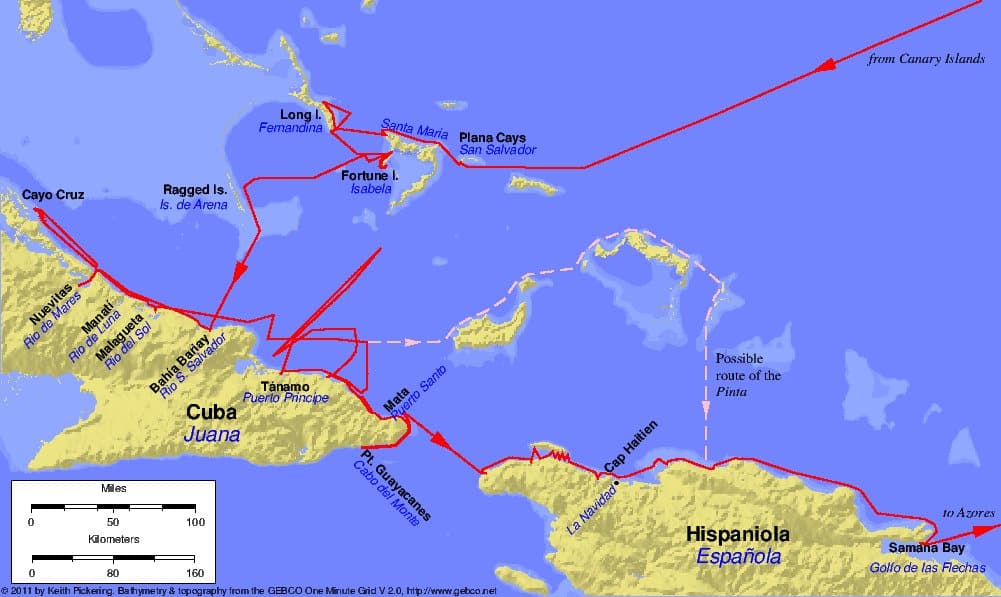
September 15 - Columbus and his crew make it to the Canary Islands.
September 20 - According to Columbus' logs, they encounter different weather conditions.
September 23 - After a short period of time, the crew begins to complain about the conditions.
October 7 - Landfall is spotted...or so they thought. They were incorrect
October 11 - The crew begins to come close to mutiny and overthrowing Columbus.
October 12 - Just at the right time, a member of the Pinta's crew spots to land. They would land on Watling's Island and name it San Salvador. Columbus believes he has reached the passage to India and China.
October 28 - Columbus makes it to Cuba.
November 26 - Martín Alonso Pinzón took the Pinta on an unauthorized expedition in search of an island called "Babeque" or "Baneque," which the natives had told him was rich in gold.
December 25 - The Santa Maria runs aground. Columbus would establish the first Spanish settlement in the New World. They would use the sunken ship for target practice to impress the natives.
January 16, 1493 - He begins his journey back to Spain.
Following Voyages
March 5, 1493 - Columbus arrived in Spain and speaks to the King and Queen about the New World and what he believes is a new route to Asia.
September 25 - 1493 - He received permission for a second voyage. This time, he will be given 16 ships carrying 1500 men. Among his crew is the future Spanish Conquistador and explorer of Florida, Ponce de Leon.
Their mission is to explore Hispaniola. While exploring, he comes into contact with the Carib and Arawak tribes. These tribes are aggressive. Regardless, he is able to establish another settlement he called Haiti.
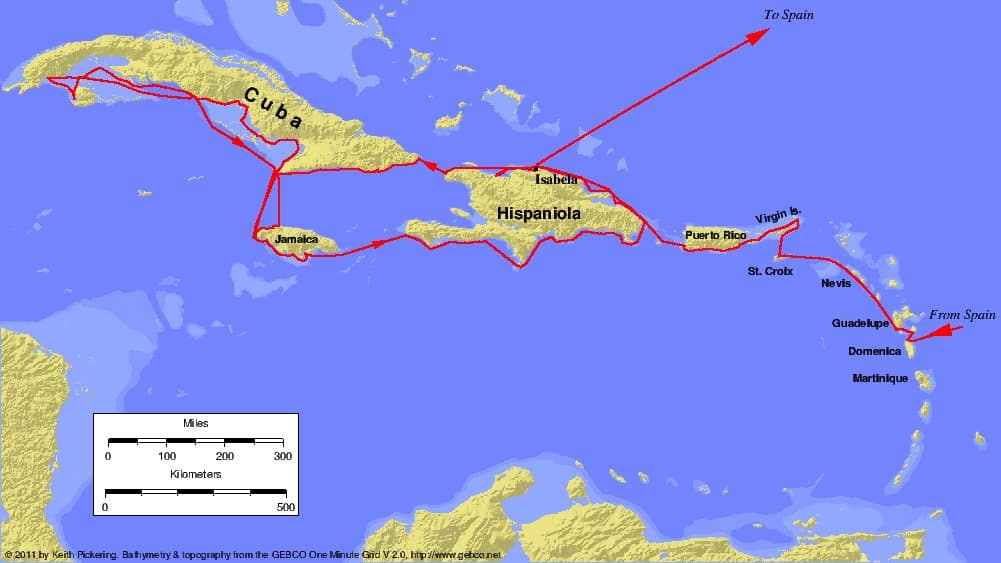
September 29, 1494 - Columbus returns to Spain and prepares for a third voyage.
May 30, 1498 - Christopher Columbus leaves for his third voyage from Seville, Spain. This voyage would prove to be more difficult for him.
July 31, 1498 -The crew sites Trinidad. This is the most southerly island in the Caribbean.
August 5, 1498 - Columbus sent several small boats ashore on the southern side of the Paria Peninsula in what is now Venezuela, near the mouth of the Orinoco River. This was the first recorded landing of Europeans on the mainland of South America.
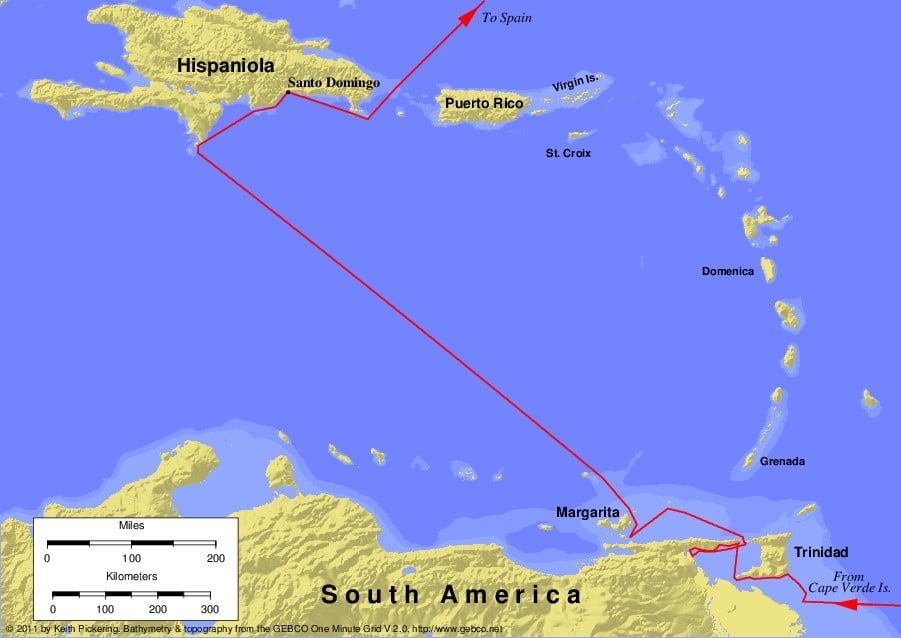
August 19, 1498 - He returns to Hispaniola. There, he found settlers in rebellion against his rule and his unfulfilled promises of riches. Christopher Columbus had some of the Europeans tried for their disobedience; at least one rebel leader was hanged.
October 1499 - Columbus sent two ships to Spain, asking the Court of Spain to appoint a royal commissioner to help him govern. By this time, accusations of tyranny and incompetence on the part of Columbus had also reached the Court.
The sovereigns sent Francisco de Bobadilla, a relative of Marquesa Beatriz de Bobadilla, a patron of Columbus and a close friend of Queen Isabella, to investigate the accusations of brutality made against the Admiral.
1500 - 1501 - Bobadilla makes landfall at Santo Domingo. Here, he learns of Columbus and his brother's brutal tactics. He orders them to be thrown into prison, where they were harshly treated. He then loads them up and sends the discoverer of the New World home in chains.
Upon arriving in Spain and the royals seeing what had been done to the three brothers, they had all their privileges restored; Christopher Columbus then proposes another voyage to the New World.
May 9, 1502 - Columbus left Cádiz with his flagship Santa María and three other vessels. The ships were crewed by 140 men, including his brother Bartolomeo as second in command and his son Fernando.
He sailed to Arzila on the Moroccan coast to rescue Portuguese soldiers said to be besieged by the Moors.
The siege had been lifted by the time they arrived, so the Spaniards stayed only a day and continued on to the Canary Islands.
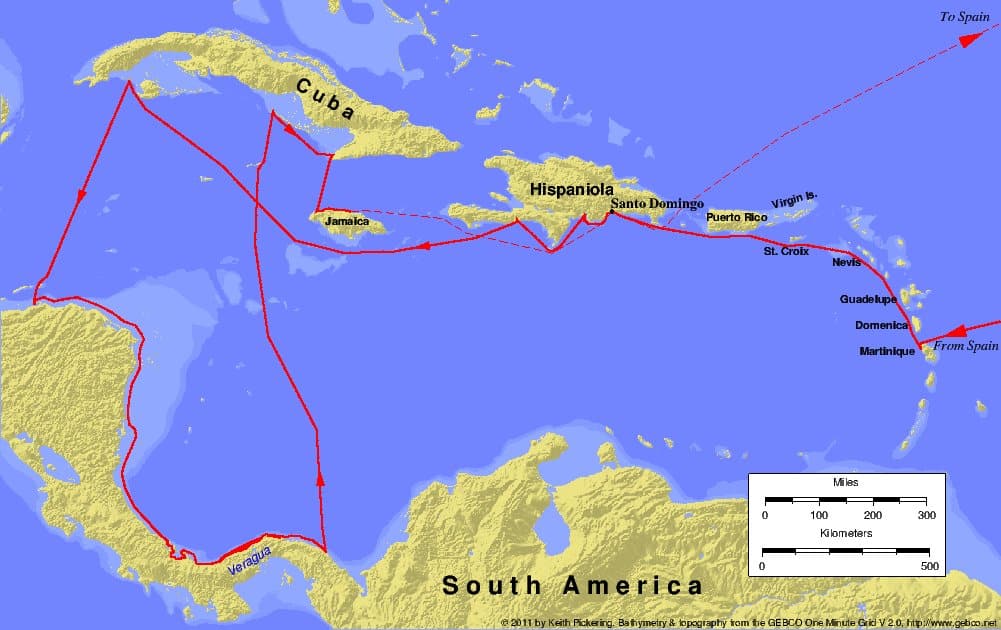
June 15, 1502 - The fleet arrived at Martinique, where it lingered for several days. A hurricane was forming, so Columbus continued westward, hoping to find shelter on Hispaniola.
June 29, 1502 - He arrived in Jamaica but was denied port, and the new governor, Francisco de Bobadilla, refused to listen to his warning that a hurricane was approaching.
Instead, while Columbus's ships sheltered at the mouth of the Rio Jaina, the first Spanish treasure fleet sailed into the hurricane.
Columbus's ships survived with only minor damage, while 20 of the 30 ships in the governor's fleet were lost, along with 500 lives (including that of Francisco de Bobadilla).
Although a few surviving ships managed to struggle back to Santo Domingo, Aguja, the fragile ship carrying Columbus's personal belongings and his 4,000 pesos in gold, were the sole vessels to reach Spain.
November 7, 1502 - Christopher Columbus returns to Spain after surviving a terrible situation in the tropics that almost led to his death. This would be his final voyage, and he would never see the New World again.
1502 - 1505 -During the rest of these years, Columbus published two books. The first being the Book of Privileges, and the second being the Book of Prophecies.
May 20, 1506 - Christopher Columbus dies in Valladolid, Castile.
